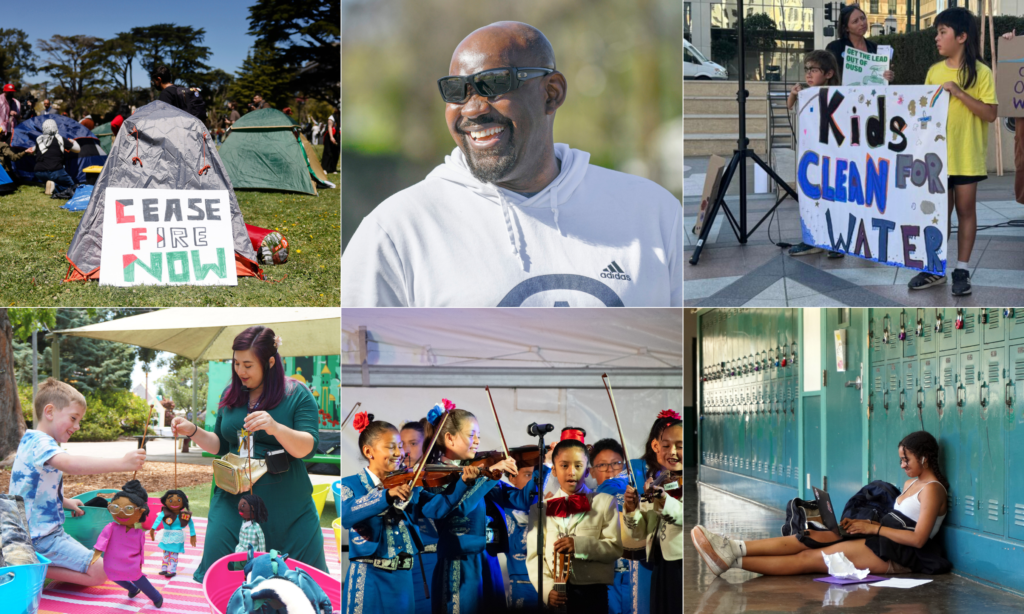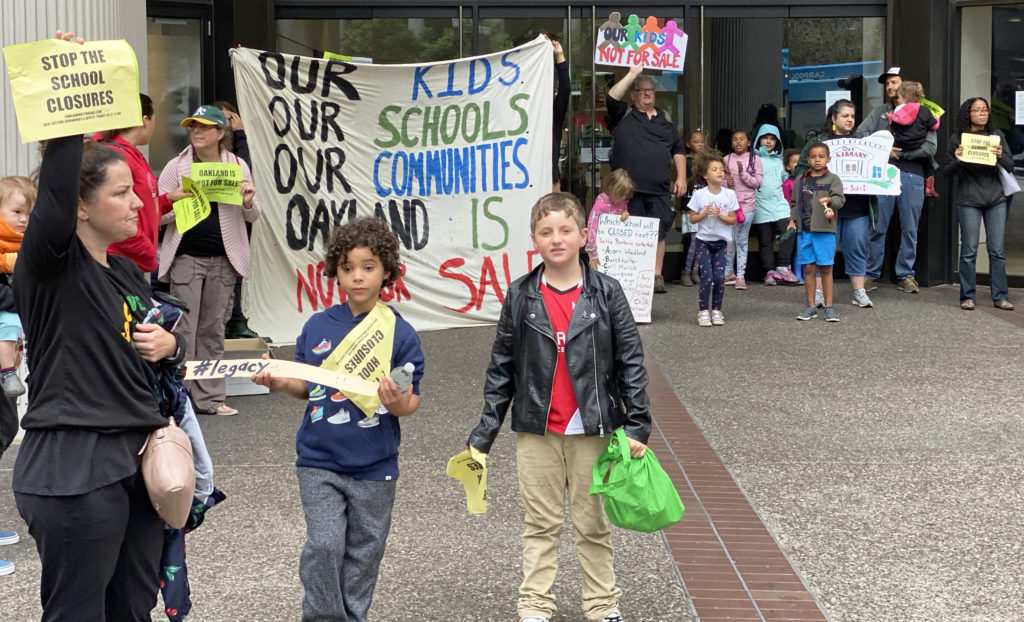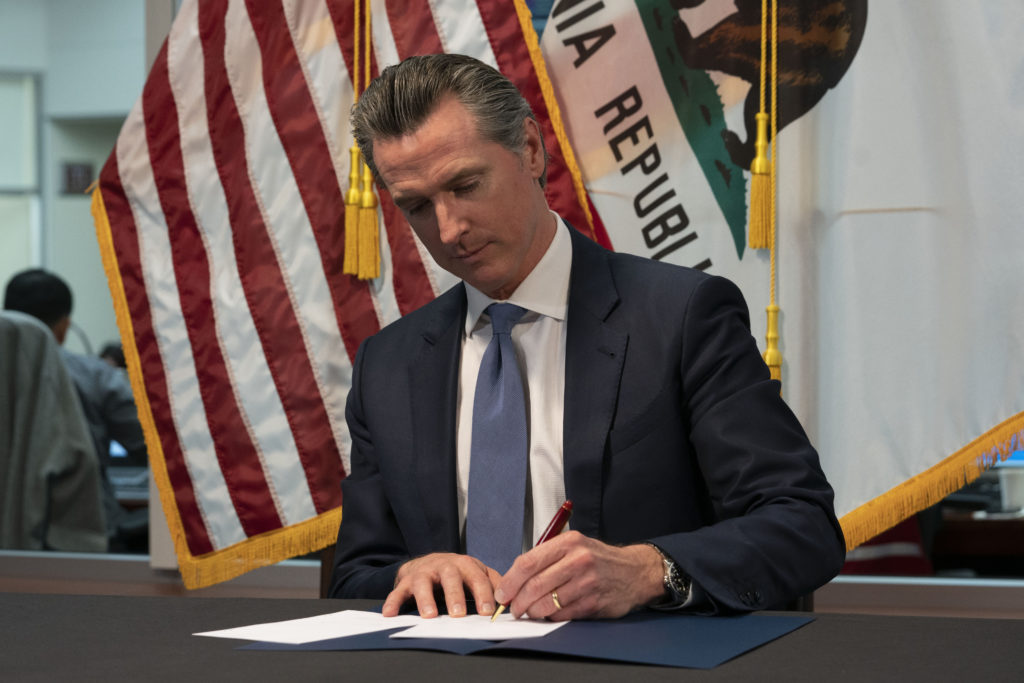
Two students share a bench during lunch at Rudsdale Newcomer High School in Oakland.
Anne Wernikoff for EdSource
Este artículo está disponible en Español. Léelo en español.
In the first months of the first Trump administration in 2017, a father in Los Angeles was detained by Immigration and Customs Enforcement (ICE) after dropping his 12-year-old daughter off at school.
The ripple effect was immediate.
“Right away there was a drop in attendance in L.A. schools because parents were thinking, ‘Oh, if I drop off my kids, ICE is going to pick me up,’” said Ana Mendoza, senior staff attorney at ACLU of Southern California and director of the organization’s Education Equity Project. “The need for safety and sanctuary policies became really salient because students weren’t going to schools or families were tentative about their participation in schools.”
In the wake of this year’s presidential election, there is again widespread uncertainty among immigrant families in California about what is to come, given President-elect Donald Trump’s promises of mass deportation.
State Attorney General Rob Bonta recently released updated guidelines and model policies about what K-12 schools, colleges and universities can and cannot do under state and federal law, regarding keeping immigrant students and families’ data private, when to allow an immigration enforcement officer on campus, how to respond to the detention or deportation of a student’s family member, and how to respond to bullying or harassment of a student based on immigration status.
The original guidelines and policies were released in 2018 by then-Attorney General Xavier Becerra, after California passed Assembly Bill 699, requiring schools to pass policies that limited collaboration with immigration enforcement. Bonta is now asking schools to update their policies.
“School districts should be examining what their board policies are and to make sure they’re updated and take any measures to make sure that families feel safe,” Mendoza said.
An estimated 1 in 10, or 1 million, children in California have at least one undocumented parent. And about 133,000 children in California public schools are undocumented themselves, according to the Migration Policy Institute.
In California’s colleges and universities, an estimated 86,800 students are undocumented, and about 6,800 employees in TK-12 schools, colleges and universities have temporary work permits and protection from deportation under Deferred Action for Childhood Arrivals, or DACA, according to the Higher Ed Immigration Portal.
“Undocumented students and faculty and staff are afraid for their safety, and this will impact their retention and enrollment in higher education if they’re not feeling safe or they’re feeling targeted,” said Luz Bertadillo, director of campus engagement for the Presidents’ Alliance for Higher Education and Immigration, a national organization of college and university leaders. “For campuses to have a strong stance on what they’re doing to support undocumented students is important, or at least letting their students know they’re thinking about them and they’re taking action. Even though they cannot guarantee their safety, at least they’re taking those initiatives to safeguard.”
What rights do immigrant students and family members have at school and college, regardless of their immigration status?
The right to attend public school
All children present in the United States, regardless of immigration status, have a right to attend public school. In 1982, the Supreme Court ruled in the case Plyler v. Doe that states cannot deny students a free, public education based on their immigration status or their parents or guardians’ immigration status. Some states — including California in 1994 with Proposition 187 — and school districts have since attempted to pass laws that would either deny enrollment to students who did not have valid immigration status or report their status to authorities, but all these laws have been struck down by courts.
California schools are not allowed to request or collect information about Social Security numbers, immigration status or U.S. citizenship when enrolling students. Students and parents do not have to answer questions from schools about their immigration status, citizenship or whether they have a Social Security number.
“This often comes up in requests for student documents,” Mendoza said. “I had an intake once where a parent gave a passport during enrollment, and the front office person was asking the parent for a visa. No. The school has no right to ask for documents about your citizenship or immigration status.”
Schools can ask for some information like a student’s place of birth, when they first came to the U.S. or attended school in the U.S., in order to determine whether a student is eligible for special federal or state programs for recently arrived immigrant students or English learners. However, parents are not required to give schools this information, and schools cannot use this information to prevent children from enrolling in school. The Office of the Attorney General suggests that schools should collect this information separately from enrolling students.
Privacy of school records
The federal Family Educational Rights and Privacy Act, or FERPA, restricts schools from sharing students’ personal information in most cases with other agencies or organizations, including federal immigration authorities. The law requires that schools get a parent or guardian’s consent before releasing any student information to another agency or organization, or if the student is 18 or older, schools must get consent from the student.
However, in some cases, schools may be required to provide information without consent in response to a court order or judicial subpoena.
Colleges are also restricted from sharing information except in certain cases. Bertadillo said her organization recommends that college leaders have conversations with all the different departments that might manage information about students’ or families’ immigration status, such as information technology, admissions, registrar, and financial aid, to review their practices for storing or sharing the data.
“We hear some campuses have citizenship status on their transcripts and those transcripts get sent to graduate schools, to jobs, and that’s essentially outing students,” Bertadillo said.
She said it’s important for colleges and schools to pass or revisit procedures about what to do if immigration officials ask for data or attempt to enter a campus.
“A lot of institutions created them back in Trump 1.0. We’re recommending they reaffirm or revisit them, so that the campus knows that this is in place,” Bertadillo said.
Safe haven at school
The Department of Homeland Security has designated schools and colleges as protected areas where immigration enforcement should be avoided as much as possible. President-elect Trump has said he may rescind this policy.
In the event that ICE officers do enter schools or ask to question students, the attorney general’s guidelines say school staff should ask officers for a judicial warrant. Without a judicial warrant, school staff are not required to give an ICE officer permission to enter the school or conduct a search, or to provide information or records about a student or family, the guidelines say.
A bill introduced by state Sen. Lena Gonzalez, D-Long Beach, and State Superintendent of Public Instruction Tony Thurmond would establish a “safe zone” of 1 mile around schools and prohibit schools from allowing ICE to enter a campus or share information without a judicial warrant.
Under California law, schools must notify parents or guardians if they release a student to a law-enforcement officer, except in cases of suspected child abuse or neglect.
California law does not require schools to notify parents or guardians before law enforcement officers question a child at school, but it does not prohibit schools from notifying them either. California’s attorney general suggests that school districts and charter schools should create policies that require notification of parents or guardians before a law enforcement officer questions or removes a student, unless that officer has a judicial warrant or court order.
In addition, the attorney general says if a police officer or immigration agent tries to enter a school or talk to a student for purposes of immigration enforcement, the superintendent or principal should e-mail the Bureau of Children’s Justice in the California Department of Justice.
“Schools should retrain their staff on their visitor management policies, to make sure everyone who comes onto campus, including law enforcement, is questioned about what their purpose is, and that school staff is trained on what to do if law enforcement asks to see information about students or staff,” said Mendoza.
Support from school if a family member is detained or deported
If a student reports that their parents or guardians were detained or deported, California law requires that the school must follow parents’ instructions about whom to contact in an emergency. The attorney general’s guidance says “schools should not contact Child Protective Services unless the school is unsuccessful in arranging for the care of the child through the emergency contact information.”
The guidance also suggests that schools should help students and family members contact legal assistance, their consulate, and help them locate their detained family members through ICE’s detainee locator system.
Mendoza said it is important to note that if a student’s parents are detained or deported, and as a result they have to go live with another family member, at that point, they are eligible for support for homeless students under the federal McKinney-Vento Act.
Protection from discrimination and harassment
Federal law prohibits discrimination and harassment based on race, national origin, color, sex, age, disability and religion. California’s law AB 699 also made immigration status a protected characteristic, meaning that schools are required to have policies that prohibit discrimination, harassment and bullying based on immigration status.
Mendoza said it’s important for families and students who experience bullying or harassment to know they can submit complaints through their schools or to different agencies in California. “There are advocates out there willing to support them if their schools do not act in accordance with best practices or with the law,” Mendoza said.
Free lunch, subsidized child care and special education
In California, all students have a right to a free school lunch, since the 2022-23 school year. In addition, some students whose families are considered low-income qualify for subsidized child care, either all day for infants and preschoolers, or after school for school-age children. Students with disabilities have a right to special education to meet their needs, under federal law.
Immigrant families are often afraid to apply for public services because they are worried this will count against them when applying for permanent residency. This is largely due to the “public charge” test, which immigration officers use to determine whether green-card applicants are likely to depend on public benefits.
Currently, immigration officers can only consider whether applicants have used cash assistance for income, like SSI or CalWORKs, or long-term institutionalized care paid for by public insurance, such as Medi-Cal. They do not consider school lunch, child care or food stamps. And officers are not allowed to look at whether applicants’ family members, like U.S. citizen children, use public benefits. During the first Trump administration, the president changed this policy to include family members and some other benefits. It is unclear whether he may attempt to change this again in the future. However, even under the changes during his first term, school lunch and child care were not included.
In-state tuition and scholarships for college
Under the California Dream Act, undocumented students qualify for in-state tuition and state financial aid at California colleges and universities if they attended high school for three or more years or attained credits at community college or adult school and graduated from high school or attained an associate degree or finished minimum transfer requirements at a California community college. The number of students applying for the California Dream Act has plummeted in recent years.



















